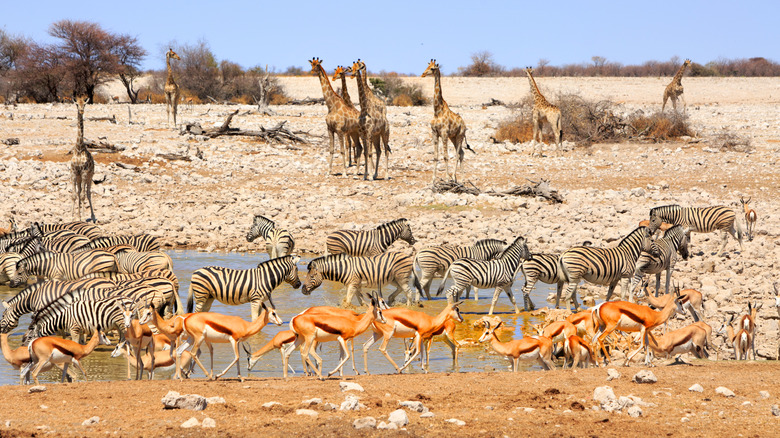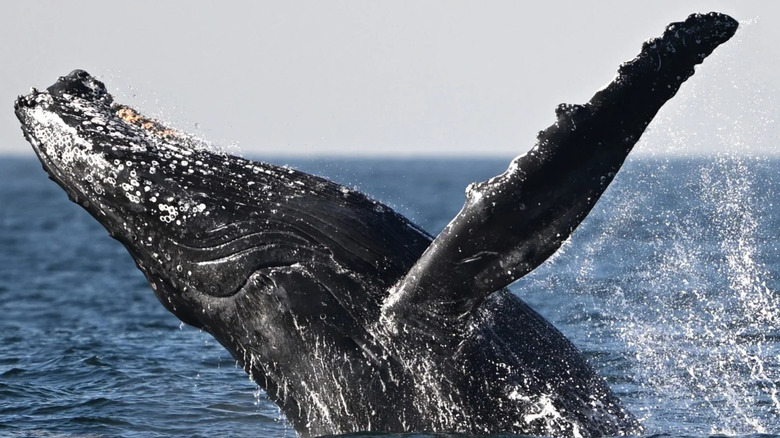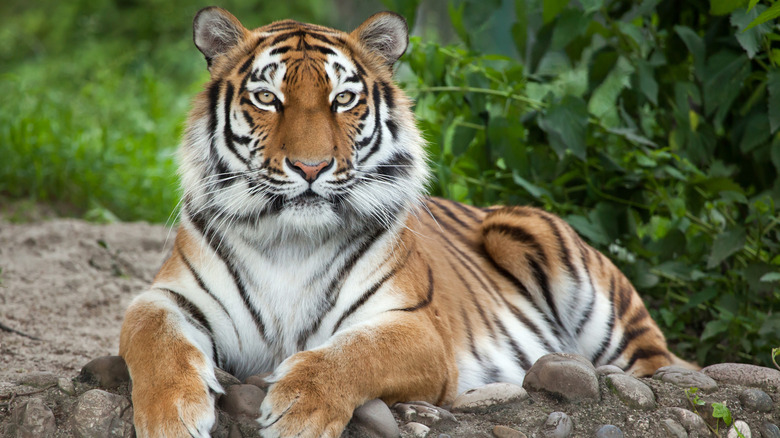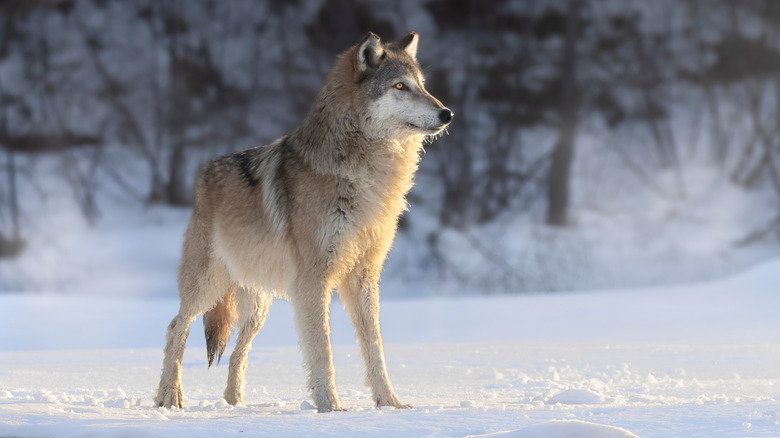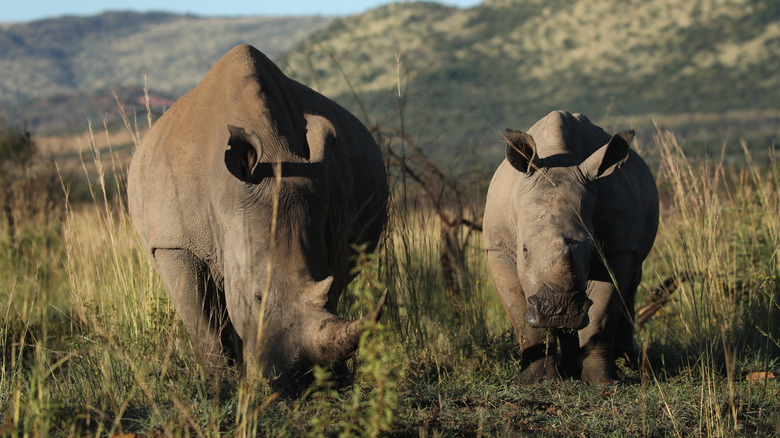Amazing Animals That Survived Near-Extinction And Made A Comeback
In a perfect world, we'd still be co-existing with the dodo, woolly mammoth, and quagga, but sadly, these are among the 900+ extinct animal species. Climate change, pollution, and human predation are just a few of the many contributing factors to the disappearance of a species. However, some animals once hovered on the brink of extinction only to make a comeback, including certain whale, tiger, bear, and wolf species.
Just as we humans directly or indirectly can cause harm to animals and play a role in essentially exterminating them, we can also help them. The resurgence of these once-endangered species proves that. Today, conservation efforts range from habitat restoration and captive breeding to reducing carbon emissions and changing shipping routes.
The World Wildlife Fund's directory list includes dozens of species that are critically endangered, endangered, or vulnerable. There are even vulnerable dog breeds that could go extinct if humans don't take action. You can help remove some animals from this list by supporting conservation organizations, reducing your environmental footprint, protecting wildlife habitats, and making informed consumer choices.
Eastern North Pacific gray whales faced extinction twice
In the 19th and early 20th centuries, hunters targeted gray whales for their blubber, which they used to make oil for lamps. The popular dwelling spots of these sea mammals made them easy to spot. Unlike other whales, gray whales are bottom feeders that migrate near the coast. Plus, the warm, shallow waters near Baja California in Mexico offer the perfect environment for nursing mothers, which led to a spike in the slaughtering. Whale hunters went to these lagoons to kill the whales that were pregnant or nursing, killing the calves as well.
As a result of these killings, all eastern North Pacific gray whales were almost completely eliminated until the 1920s, but whaling never stopped completely. In 1946, the International Whaling Commission (IWC) was established to protect them, but the species still faced extinction, once again, in the 1950s.
The population remained scarce in the eastern North Pacific until 1994. This is when the eastern Pacific gray whale was removed from the endangered species list, thanks to the IWC, the Marine Mammal Protection Act, Endangered Species Act, and Mexico's decision to create protected refuge zones. The population declined again after 2016, with an estimated amount of around 14,526 in 2023, but appears to be on the rebound once more.
Giant pandas have been upgraded from endangered to vulnerable
Who doesn't love the adorable panda bear? It might not be the friendliest wild animal in the world, but some people would argue that it's the least hostile bear species. Unfortunately, though, the world came close to having these mammals exist only in images, videos, and memories. The species became officially endangered in 1990 as a result of habitat loss caused by infrastructure development and forest loss, which led to reduced bamboo access. These bears require a whopping 26-84 pounds of bamboo on a daily basis. Poaching also played a role in their decline before 1988, when the Wildlife Protection Act was enacted.
For decades, the iconic giant panda has served as a worldwide symbol for wildlife conservation. It was these same conservation efforts that helped save the species. These efforts included forest protection and reforestation. The species was upgraded from "endangered" to "vulnerable" category in 2016. Today, an estimated 1,864 giant pandas live in the wild. You can find another 600 residing in zoos and breeding centers.
The Siberian tiger faced extinction in the 1990s
They could kill their prey within seconds with their powerful teeth and claws, but there's still something so majestic and beautiful about Siberian tigers. Perhaps it's their black stripes against their orange fur or their mesmerizing gold eyes. Sadly, their beauty indirectly contributes to their demise; it makes them a target to poachers who hunt them for their fur and other body parts. Habitat loss and habitat degradation, partially from illegal deforestation, also led to the decline of these big cats in the 1900s.
The International Union for Conservation of Nature categorized the species as "critically endangered" in the 1990s. This category indicates a greater than 50% chance that a species would go extinct in the wild within a decade, compared to the more than 20% chance associated with the "endangered" category. While the species is starting to rebound from the brink of extinction, efforts are still needed to help them overcome their endangered status.
North American gray wolves were once heavily hunted for their fur
Wolves don't have desirable features like horns, orange striped fur, or blubber. After all, they belong to the canid family, just like Chihuahuas, Labradors, and every other domestic dog breed. Wolves share many of the same characteristics as domesticated dogs, but they have still been hunted and killed by humans. While Native Americans celebrated these animals centuries ago, European settlers saw them as nothing more than a source of profit for their fur. This led to baiting, trapping, and shooting them.
In 1880, Yellowstone National Park's superintendent Philetus Norris said "The value of their hides and the easy slaughter...have nearly led to their extermination" (via National Geographic). Nearly 100 years later, the gray wolf was listed as "endangered" in 48 states after the 1973 passage of the Endangered Species Act (ESA). This act required the federal government to support recovery efforts for the species.
As a result of ESA and reintroduction efforts, the gray wolf was delisted as an endangered species in the Northern Rocky Mountains in 2011 and Wyoming in 2017. It's now classified as "vulnerable," with about 65,000 gray wolves left in North America.
Hunters target southern white rhinoceroses for their horns
You've likely seen a rhinoceros in person at a zoo, in the wild in Africa or Asia, or in a photo or on a screen without being certain of the exact species; contrary to the name, southern white rhinoceroses aren't white. They're gray. The word "white" stems from the West Germanic word "weit," which means "wide" and refers to the animal's mouth. Poaching and habitat loss caused the decline of these mammals, pushing them closer and closer to extinction in the late 19th century. Unsurprisingly, their horns are the primary reason that hunters kill them.
In 1895, fewer than 100 southern white rhinos existed in South Africa. Over the next 100+ years, the World Wildlife Fund and other conservation efforts helped the population to multiply. The U.S. Fish and Wildlife Service listed the southern white rhino as "threatened" in 2013 as a result. These efforts have continued ever since and are still making an impact. Today, the species is classified as "near threatened," and about 20,000 southern white rhinos are enjoying life, mostly in South Africa. While these species are starting to rebound, not every animal has the same luxury, making it important to continue conservation efforts and protect wildlife habitats to prevent their extinction.
